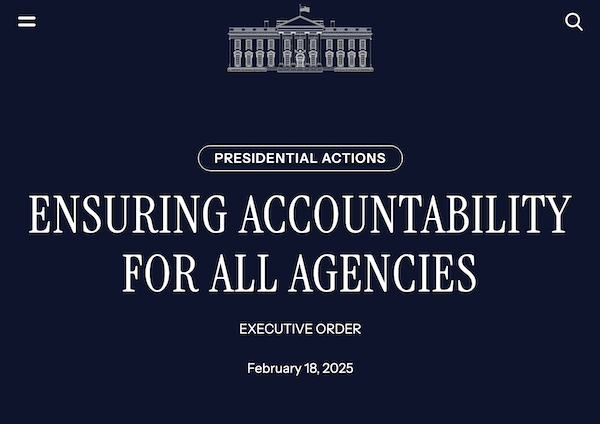Published: February 19, 2025
An investigation into the implications of President’s executive order on regulatory agency control reveals a concerning pattern of power consolidation that mirrors autocratic governance strategies.
The February 18, 2025 executive order “Ensuring Accountability for All Agencies” represents what could be the most significant expansion of presidential authority over independent regulatory agencies in modern American history. This investigation reveals a carefully constructed legal framework that could fundamentally alter the balance of power within the executive branch.
I. The Consolidation of Power
Dismantling Independent Oversight
The order’s primary mechanism for power consolidation operates through several key provisions that effectively eliminate agency independence:
- Mandatory OIRA Review: All significant regulatory actions must now pass through the Office of Information and Regulatory Affairs, creating a single point of control for the entire regulatory apparatus
- Direct Presidential Control: Previously independent agencies lose their ability to act autonomously, instead requiring White House approval for major decisions
- Political Oversight: Installation of White House liaisons in every agency creates a direct line of political control over traditionally independent functions
Structural Transformation
The order implements sweeping structural changes that remake the federal bureaucracy:
- Mandatory Consultation: Agency heads must regularly coordinate with White House officials on policies and priorities
- Budget Control: OMB gains power to restrict agency spending based on alignment with “presidential priorities”
- Strategic Planning Oversight: Agencies must submit their strategic plans to OMB for “clearance” before finalization
II. Constitutional Implications
Erosion of Checks and Balances
While wrapped in constitutional language about executive power, the order presents several concerning shifts in governmental structure:
- Centralized Authority: Consolidates vast regulatory power under direct presidential control
- Weakened Independence: Eliminates traditional buffers between political leadership and regulatory functions
- Expert Marginalization: Creates mechanisms to override career experts’ regulatory decisions with political appointees’ judgments
Democratic Safeguards at Risk
The order potentially undermines key democratic protections:
- Reduced Institutional Independence: Weakens historically independent agencies that served as checks against autocratic control
- Political Interference: Opens door for direct political intervention in technical regulatory matters
- Consolidated Control: Creates single point of failure for vast regulatory apparatus
III. Dangerous Precedents
Legal Framework Changes
Section 7 of the order creates particularly troubling precedents:
- Binding Interpretations: Makes presidential and AG legal interpretations mandatory for all employees
- Restricted Legal Positions: Prevents agencies from maintaining independent legal stances
- Politicized Legal Analysis: Enables politically motivated interpretations of law to override agency expertise
Bureaucratic Control Mechanisms
The order establishes comprehensive control over the bureaucracy:
- Direct Oversight: White House gains direct control over agency strategic planning
- Budget Manipulation: Political control over agency budgets and priorities
- Political Embedding: Mandatory Schedule C appointees in key liaison positions
IV. Practical Implications
Regulatory Capture Risks
The real-world effects could be far-reaching:
- Financial Regulation: Enables direct political control over financial oversight
- Consumer Protection: Creates pathway for weakening consumer safeguards
- Industry Influence: Centralizes access points for corporate lobbying
Policy Implementation Concerns
The order creates mechanisms for rapid policy changes:
- Blocked Regulations: Allows administration to prevent or modify regulations without public input
- Policy Instability: Enables dramatic regulatory shifts with each new administration
- Expertise Diminishment: Reduces role of scientific and technical expertise in rulemaking
V. Conclusion: Democratic Erosion
This investigation reveals a pattern consistent with democratic backsliding seen in other nations, where legal mechanisms are used to consolidate power while maintaining a veneer of democratic legitimacy. The order’s comprehensive approach to centralizing executive control, combined with its potential for rapid implementation of sweeping policy changes, presents a serious concern for the future of American democratic governance.
The structural changes implemented by this order could outlast any single administration, creating a framework for potential autocratic control that future presidents might exploit. The combination of centralized power, weakened independence, and political control mechanisms represents a significant shift away from traditional American democratic safeguards.
This analysis is based on detailed examination of the executive order text and accompanying analysis documents. Sources include official government documents and legal analyses.


